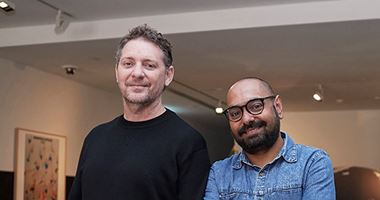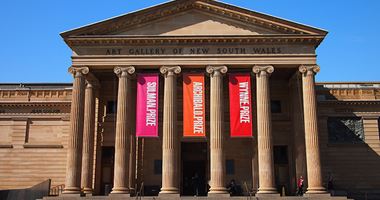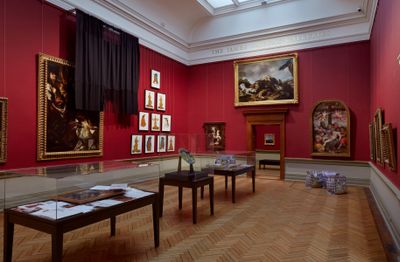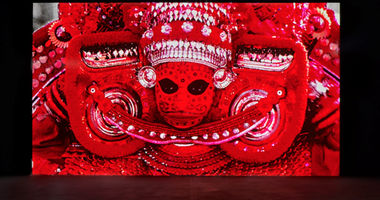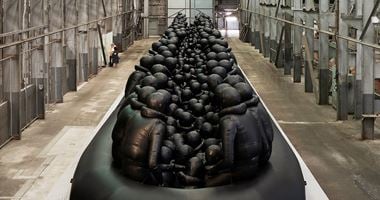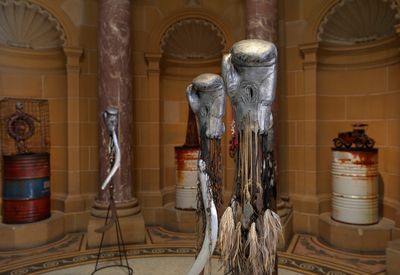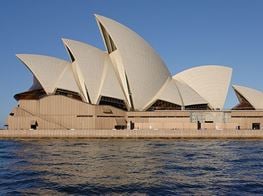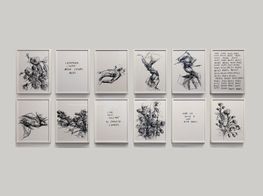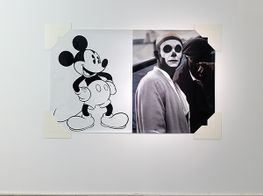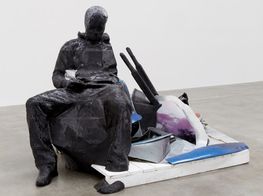22nd Sydney Biennale Connects Here with Everywhere in 2020
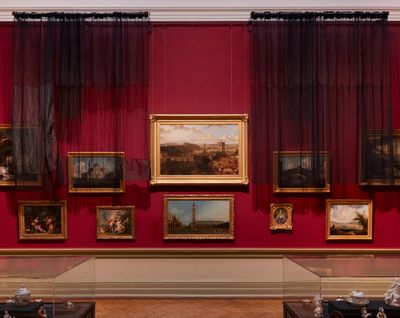
Joël Andrianomearisoa, There might be no other place in the world as good as where I am going to take you (2020). Exhibition view: NIRIN, 22nd Biennale of Sydney, Grand Courts, Art Gallery of New South Wales, Sydney (14 March–8 June 2020). Courtesy Biennale of Sydney. Photo: Zan Wimberley.
The biennial exhibition can often seem like a presentation of artworks sourced from across the world and shown in ad hoc, deterritorialised biennial venues. By contrast, the 22nd Biennale of Sydney (BoS) (14 March–8 June 2020) demonstrated a much-lauded and concerted effort to engage with the haunted histories of the sites involved.
Such dedication fits perfectly with what Brook Andrew, the first director of First Nations descent to lead the world's third oldest biennial, attempted to reflect in the title and theme of NIRIN, meaning 'edge' in Wiradjuri. By looking to the edges, histories previously relegated to the periphery become central in works by over 100 artists and collectives from 36 countries. These were presented over six venues before the exhibition shifted online due to the coronavirus outbreak: Cockatoo Island, Art Gallery of New South Wales (AGNSW), the Museum of Contemporary Art Australia, the National Art School, Artspace, and Campbelltown Arts Centre.
Cockatoo Island has been an official BoS venue since 2008: an island in Sydney Harbour that was a convict penal establishment from 1839 to 1869, retaining over 80 heritage listed colonial buildings. A quiet square in the middle of a group of rough sandstone colonial buildings hosted Tony Albert's installation Healing Land, Remembering Country (2020), which invited visitors to pause and engage with the context as a place of 'active memory'.
Albert erected a makeshift greenhouse containing native Australian grasses and plants from throughout New South Wales, sourced with the help of Muru Mittigar Nursery, a Darug organisation that specialises in growing local plants from providence seeds. Temporary wooden shelves laden with various plants surrounded tables and chairs, with visitors invited to write 'a positive memory' on thin strips of paper that are embedded with seeds of local plants and planted, thereby rejuvenating the ecosystem through personal remembrance.
In the Turbine Hall, the largest building on Cockatoo Island, Lhola Amira's sound installation Philisa: Ditaola (To Heal: Divining Bones) (2018–2020) consisted of seven portals with circles of salt naturally evaporated from Australian seas and beaded curtains of red, white, and blue hanging from the ceiling. Visitors were encouraged to stand in these portals, where a wash of sound composed of gentle choral voices was audible. The work is an act of grounding: an intervention for healing and rest, with visitors leaving footprints on the Australian salt as they moved through the ensemble.
Works like these concatenate ancient cultures, invoking intangible cultural heritages.
Sound installations were common throughout Cockatoo Island, demonstrating ways to sonically harness the active memory of place. Mohamed Bourouissa's large-scale installation Brutal Family Roots (2020) covered an entire hall in wattle-yellow carpet, the space itself filled with music recordings created in collaboration with MC Kronic, a Waddi Waddi man of the Yuin Nation; Nardean, an Egyptian-Australian singer; and French sound designer Jordan Quiqueret. Spoken poetry and rap connect disparate localities in their shared experiences of colonisation and dislocation. 'Endeavour, Endeavour, Endeavour / Then he came / Red and blue coats / Elongated muskets' voices sing at one point, referencing Captain Cook's arrival on the HMS Endeavour in 1770. In this building, on the highest knoll of the island, open windows overlook the sparkling sea of the harbour: a vantage point to imagine what the First Nations people on Cockatoo Island might have witnessed when Cook landed.
Meanwhile, speakers installed throughout the Military Guardhouse, an open-air sandstone structure adjacent to the convict precinct, formed part of Gina Athena Ulysses' installation An Equitable Human Assertion (2020). Ulysses sings in both English and Creole about 'the practices of human domination and control' and ways to create 'possibilities for new encounters.' These philosophical musings resonated throughout the site. 'Without visions we don't know what to build, only what to knock down,' Ulysses sings, as if addressing the building.
Works like these concatenate ancient cultures, invoking intangible cultural heritages. Their constellations do not generalise or homogenise, but instead respectfully reveal the modes of shared solidarity, survival, and endurance that interconnect in the global narratives that Andrew has curated throughout BoS.
At AGNSW's grand courts, fascinating encounters were staged between BoS artists and the institution's historic European, colonial, and early 20th century Australian art collection, with works woven into the collection. Emily Karaka's painting Kingitanga ki Te Ao (They will throw stones) (2020), for instance, referencing the Māori land rights to preserve Indigenous sovereignty, was exhibited next to Milford Sound, New Zealand (1877–1879) by Eugene von Guerard. Karaka's emphatic plea to 'save our unique landscape' and her depiction of three Māori flags—staunch assertions of Indigeneity—was positioned in dialectical opposition with von Guerard's German Romantic depiction of a white-washed landscape, absent of Indigenous people.
The black curtains comprising Joël Andrianomearisoa's There might be no other place in the world as good as where I am going to take you (2020) were hung throughout the 13 spaces. Described as a 'counter-architecture', soft folds—some opaque, some transparent with mesh and lace—contrasted with the towering white European archways and columns. At points, they completely covered entire paintings and walls; in other instances, they veiled entrances, rustling as visitors moved between rooms.
Electro soundscapes performed a similar intervention in the galleries, punctuating the rarefied solemn silence that usually occupies AGNSW's grand courts. These came from Nicholas Galanin's video Tsu Héidei Shugaxtutaan (We Will Again Open This Container of Wisdom That Has Been Left in Our Care) Part II (2006) and the various clips from Arthur Jafa's filmic collage The White Album (2018).
The latter is a highlight of NIRIN, with Jafa turning his lens towards whiteness as a social construct. At one point there is a six-minute clip of YouTube personality Dixon White and in his rigamarole on whiteness he pronounces that 'white supremacist institutions, culture . . . whitewash history and education.' Amidst a Eurocentric art collection amassed in a settler colonial state, White's words ring profoundly true. The large projection was placed directly in front of an archway, obstructing visitors and insisting on being viewed.
An insistence on visibility framed the AGNSW exhibition from the outset. Inside the gallery's vestibule, designed by colonial architect WL Vernon, Karla Dickens' installation A Dickensian Circus (2020) contextualises AGNSW and BoS as institutions complicit in perpetuating systems of violence against First Nations artists. Referencing the histories of Indigenous people involved in circus shows and tent boxing troupes at agricultural shows, wire cages and rusted dolls were presented next to a wall text that read, in part: 'the Art Gallery of New South Wales vestibule is a perfect post-colonial backdrop.' The gesture provokes the question: is the art world really exempt as a form of harmful entertainment, spectacle, and mindless consumption?
By looking to the edges, histories previously relegated to the periphery became central in works by over 100 artists and collectives from 36 countries presented over six venues
Such self-reflexivity was further demonstrated at Campbelltown Arts Centre with works like Denilson Baniwa's Performance Pajé-Onça Hackeando a 33ª Bienal de Artes de São Paulo (2019), a 15-minute video documenting Baniwa's protest performance at the 33rd Bienal de Sāo Paulo (7 September–9 December 2018) in which he walks around gallery spaces searching for works by First Nations artists. He is only able to find ethnographic photos taken in 1923 by an Austrian ethnologist.
In contrast to the Bienal de Sāo Paulo, this year's Biennale of Sydney seems like a corrective, prioritising autonomy in an international exhibition format that has all too often omitted or sidelined First Nations artists. Imbued with exigency of politics and the urgency of activism, the overall tone is declarative and unflinching. In works like Elle-Máijá Tailfeathers' single-channel video Bihttoš (Rebel) (2014), an intimate account of the lived experiences of Indigenous activists through the lens of the love story between her Blackfoot mother and Sámi father, the personal and political coagulate into a multivalent conversation.
As Eve Tuck and K. Wayne Yang argue in their 2012 essay 'Decolonization Is Not a Metaphor', colonialism is comprised of global and historical relations. NIRIN reflects on this reality by revealing how such relations have not only affected Australia and its neighbours, but have shaped the entire world order. The work of decolonisation involves everyone; not just here, but everywhere. —[O]


